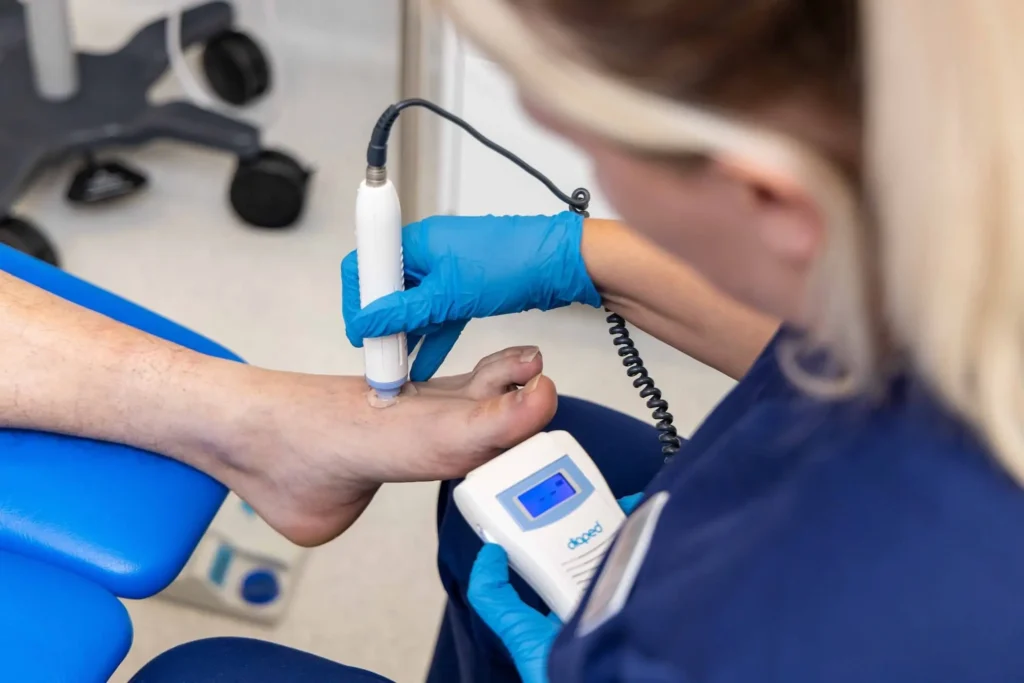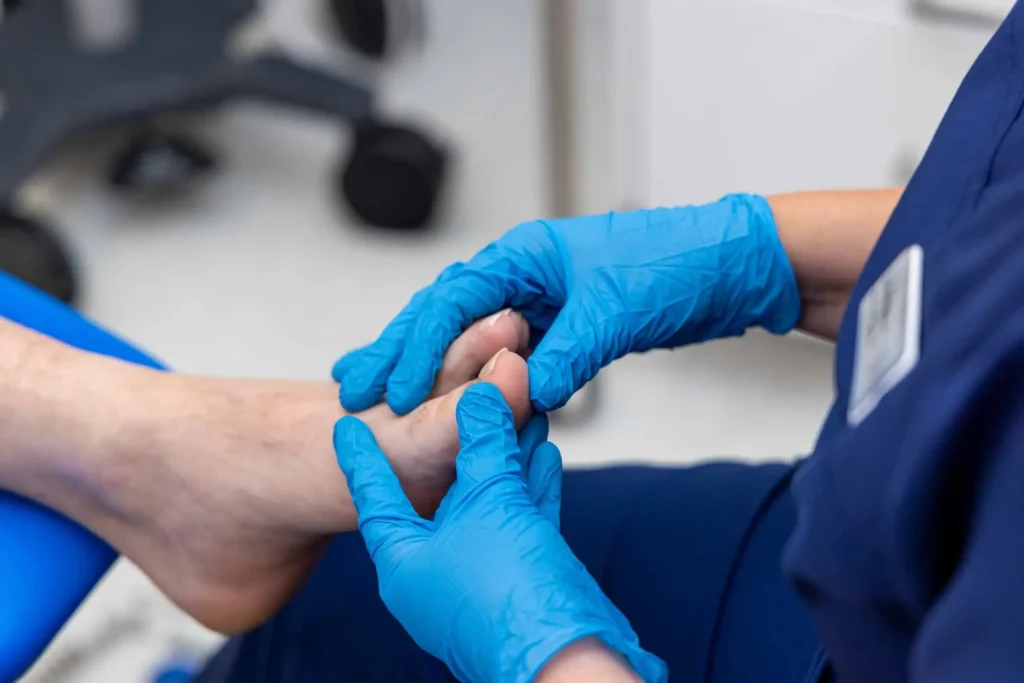DIABETIC FOOT CARE

Services
WHAT IS SPECIAL ABOUT DIABETIC FEET?
Diabetes can impact the feet in many ways and is the leading cause of ulceration and amputation, for this reason special care and attention is required. Poorly controlled Diabetes can lead to nerve damage and impaired blood supply. This means that injuries may go unnoticed, and healing is impaired. Because diabetes can also lead to retinopathy (impaired eyesight), visual symptoms may be missed as well.
Nerve damage can also lead to muscle weakness in your feet and cause a loss of coordination and balance. The Key to reducing risks of Diabetic foot complications is to maintain control of your blood sugar levels and to have regular professional foot care and advice.
WHAT CAUSES DIABETIC FOOT PROBLEMS?
Diabetic foot problems develop primarily from three major complications of diabetes:
1. Poor Circulation (Peripheral Vascular Disease)
- Reduced blood flow to your feet
- Slower healing of wounds and injuries
- Increased risk of infection
2. Nerve Damage (Peripheral Neuropathy)
- Lack of sensation in your feet
- Inability to feel pain, heat, or cold
- Unnoticed injuries that can worsen without treatment
- Muscle weakness affecting foot structure and balance
3. Reduced Defence (Impaired Immune System)
- Reduced ability to fight infections
- Faster spread of infections
These three factors often work together, creating a dangerous combination where injuries occur without pain (due to neuropathy), heal poorly (due to reduced circulation) and infections are more serious.
WHAT ARE THE COMMON SIGNS AND SYMPTOMS TO WATCH OUT FOR?
Early signs of diabetic foot problems include dry or hard skin, reduced sensation, and feet feeling colder than usual, often due to nerve damage and reduced blood flow. People with diabetes are also more prone to infections such as fungal nails, athlete’s foot, and verrucae due to a weakened immune system.
Long-term diabetes can manifest in various foot issues, including swelling in the feet or ankles, dry and cracking skin, slow-healing wounds, infections of the skin and nails, discoloration, and a diminished ability to balance, all stemming from damage to nerves and blood vessels caused by high blood sugar levels.

HOW CAN DIABETIC FOOT PROBLEMS BE TREATED?
A diabetic foot assessment from a podiatrist can help keep your feet in good condition and monitor or prevent problems. During this appointment, your podiatrist will carry out neurological, vascular, structural and skin assessments to identify your risk level and offer appropriate advice and treatment.
Incorrect nail cutting and skin care practices are a major contributor of foot complications, often leading to ingrown toenails, cuts, infections, and even ulcerations requiring significant treatment. Regular professional routine foot care can significantly reduce your risk of foot complications and allows for early detection if a problem arises.
If a problem has occurred with your feet it is important to visit a Podiatrist as soon as possible. Early detection and treatment can dramatically improve your outcome and reduce your risk of larger complications.
Areas of high pressure often lead to the formation of hard skin, corns and ulceration. Orthotics, prescription inserts for your shoes, are commonly used to redistribute pressure away from these areas to reduce the risk of ulceration. Custom orthotics made for your feet and your specific problems are preferable.
We are one of the only clinics in the UK to be able to offer high-level laser therapy that is proven to help treat neuropathic pain and to regenerate damaged nerve tissue.
HOW CAN WE HELP YOU?
At MyFootMedic, our expert Podiatrists are specialists in assessing, diagnosing and treating diabetic foot conditions. We take diabetes very seriously — it’s the leading cause of foot ulceration and amputation.
We offer:
- Diabetic foot assessments
- Routine foot care
- Specialist care for conditions such as ingrown toenails, corns, or ulcerations
- Advice on footwear and at-home foot care to prevent diabetic foot complications
- Insoles and orthotics to reduce your risk of corns and ulceration
- MLS MiS High-level laser therapy for nerve pain
- Referrals to appropriate healthcare services when needed
LET’S ANSWER YOUR DIABETIC FOOT CARE QUESTIONS!
People with diabetes should have a comprehensive foot assessment at least once a year, or more frequently if you have a higher risk level.
If you have good vision and are deemed low risk, you can cut your own toenails. However, always take extra care, use proper nail clippers and ensure the nails are not cut too short. If you have neuropathy or circulation problems, it’s safer to have a podiatrist trim your nails to reduce your risk of diabetic foot complications.
Look for shoes with a wide and deep toe box, a secure fastening and appropriate cushioning. Avoid high heels, pointed toes, and flip flops. Always break in new shoes gradually and check your feet regularly for signs of rubbing or pressure marks.
Clean it gently with mild soap and water, apply an antiseptic, and cover the area with a sterile bandage. Most importantly, contact your podiatrist immediately, as even minor wounds require professional attention for people with diabetes.
Maintaining a healthy BMI reduces pressure on your feet and can improve circulation. Weight management is an important part of overall diabetes care and can significantly reduce foot complications.









